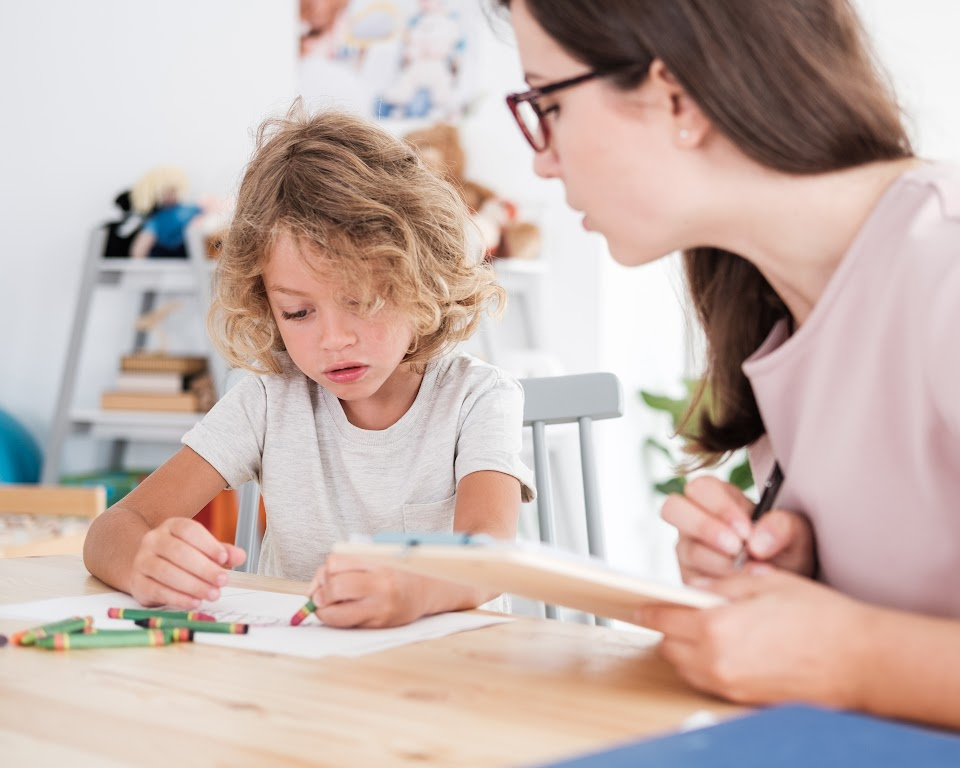It's crucial to know that students with autism and ADHD need special study strategies. Autism…

How to Get Autistic Child to Listen: A Step-by-Step Guide
For parents and educators alike, understanding how to get an autistic child to listen is a journey of patience, love, and strategy. Each child with autism brings a unique set of skills and challenges, especially when it comes to communication.
If you’re looking for effective ways to engage an autistic child, know that you are not alone in your quest for fostering a harmonious connection. Together, let’s explore compassionate and purposeful strategies for enhancing listening abilities in children with autism.
Listening, as you may already recognize, is not solely about hearing sounds; it’s about understanding and processing. Moreover, fostering receptive communication in autism requires us to stretch beyond conventional methods, harnessing the power of tailored approaches designed to resonate with your child’s unique needs.
Stay tuned as we delve into actionable insights and techniques that promise to enlighten and empower both you and your child on this communicative voyage.

Understanding Your Autistic Child’s Communication Needs
Every child with autism is unique, exhibiting a distinct range of abilities and preferences that influence their communication efforts. As a parent or caregiver, grasping these nuances can empower you to tailor your approach effectively.
Enhancing communication with your autistic child not only strengthens your bond but also supports their developmental journey. Implementing targeted communication strategies for an autistic child, and staying attuned to their specific needs, can pave the way to improving their listening skills in autism and overall engagement.
Let’s explore several methods and techniques aimed at improving your autistic child’s ability to listen and connect with you, which are essential components in their growth and learning processes.
Recognizing Individual Differences in Autism
Autistic children might struggle with traditional conversational cues, yet they can engage deeply when discussions revolve around their areas of interest. By acknowledging and adapting to your child’s individual communication style, you can employ techniques for getting your autistic child to pay attention more effectively. This customization is a vital first step in enhancing communication with an autistic child.
Creating Engagement Through Interest-Based Topics
One of the most successful methods to engage with an autistic child is by initiating conversations that align with their interests. Whether it’s a favorite book, a fondness for certain textures, or a preoccupation with a particular subject, weaving these themes into your interactions can captivate your child’s attention, fostering an environment conducive to active listening in autism.
Building on Conversational Strengths
Identifying and building upon your child’s conversational strengths can lead to breakthroughs in communication. This might involve balancing listening with speaking, encouraging your child to express their thoughts, and patiently guiding them towards a mutual dialogue. These efforts contribute towards building connections through active listening in autism.
| Techniques | Benefits | Considerations |
|---|---|---|
| Visual aids and prompts | Anchor abstract concepts and facilitate understanding | Needs to be tailored to child’s visual processing ability |
| Interest-based discussion starters | Increases enthusiasm and focus on communication | Requires knowledge of child’s ongoing interests |
| Positive reinforcement | Motivates continued engagement and listening | Should be immediate and meaningful to the child |
| Consistent communication routines | Builds comfort and predictability into interactions | Routines should evolve with the child’s development |
Each child on the autism spectrum will resonate differently with various strategies, and it’s crucial to remain flexible and patient as you discover what works best for your child. Regularly reflecting on these methods and adapting them over time will not only aid in improving listening skills in autism but also contribute to your child’s overall growth and well-being.

Developing Effective Routines and Visual Supports
If you are exploring tips for improving listening skills in autistic children, understand that consistency is key. For children with autism, fostering active listening doesn’t happen overnight. It’s a gradual cultivation that relies on sensory-friendly approaches and strategic reinforcement.
Developing language and listening skills in an autistic child hugely benefits from everyday routines that incorporate learning opportunities. Simple, predictable activities tied to daily life can become cornerstone practices for enhancing auditory engagement.
By weaving listening exercises into these moments, you provide a familiar and safe structure that children can depend on, aiding in their ability to focus and process auditory information.
Let’s consider a sensory-friendly environment, for instance. Many autistic children are sensitive to overstimulation, hence the need for a setting that soothes rather than distracts. Such an environment not only promotes comfort but also paves the way for more effective listening and learning experiences.
| Activity | Listening Skill Focus | Visual/Auditory Support |
|---|---|---|
| Storytime | Following a narrative | Pictures in book, quiet room |
| Mealtimes | Conversational turn-taking | Picture cards, soft background music |
| Playtime | Responding to verbal cues | Toys that make sounds, visual prompts |
| Dressing | Understanding and following instructions | Sequence charts, calming colors |
Remember, when integrating these tips into your daily routine, flexibility remains crucial. Each child with autism is unique, and what works for one may not work for another. Be ready to adjust the sensory-friendly approaches you employ to align with your child’s changing needs and responses.
This adaptability will not only maintain their comfort but also encourage continual progress in fostering active listening in children with autism.
Centered on the premise that every child can improve with the right support, we can confidently pursue methods that nurture their developmental journey. So, as you aim at developing language and listening skills in an autistic child, the partnership of structured routines and tailored visual supports stand as your steadfast allies.

How to Get Autistic Child to Listen: Integrating Behavioral Strategies
If you’re seeking behavior management techniques for encouraging listening in autistic children, understanding the impact of behavioral strategies is pivotal. These approaches can effectively fortify the listening abilities in children with autism, ensuring they become more receptive and attentive.
By supporting engagement and attention, you’re not just teaching listening skills but also empowering your child to navigate social situations with greater ease.
Positive Reinforcement and Reward Systems
When it comes to teaching listening skills to an autistic child, positive reinforcement plays a crucial role. Implementing a reward system encourages your child to perform desirable behaviors by associating these actions with positive outcomes.
For instance, verbal commendations, or allowing them to spend time with a favorite toy, can make attentive listening a much more appealing activity. Each child is unique, and so the rewards should be personalized to excite and motivate them, supporting engagement and fostering a positive relationship towards listening.
Teaching Active Listening and Turn-Taking Skills
Active listening and turn-taking do not just enhance conversational skills; they are integral strategies for enhancing listening abilities in children with autism. It’s about teaching the value of exchange in communication helping your child understand when to speak and when to listen.
Through games and collaborative activities, you can scaffold these skills in a fun, non-threatening environment. The consistent practice of such skills will provide your child with the tools they need to engage in social dialogues more effectively.
Using Technology and Visual Schedules to Improve Comprehension
Leveraging technology and visual schedules also contributes to the repertoire of strategies to support listening in autistic children. Tablet apps, for example, can be programmed with reminders and auditory cues that assist in directing your child’s attention to listening tasks.
Additionally, visual schedules serve as a roadmap for the day’s activities, which can include specific times dedicated to listening. This could improve comprehension and anticipation for listening exercises, making them a predictable and thus more manageable part of their daily routine.
FAQ
What are the key steps to getting an autistic child to listen?
Engaging an autistic child in listening involves understanding their communication needs, using interest-based topics to create engagement, building on their conversational strengths, developing effective routines and visual supports, and integrating behavioral strategies like positive reinforcement and reward systems. Consistency, patience, and tailoring approaches are equally critical.
How can I understand my autistic child’s communication needs better?
To better understand your child’s communication needs, observe their behavior, consider their interests, and note what kinds of interactions they respond to positively. Working with professionals like a behavioral therapist or speech therapist can also provide valuable insights into their unique preferences and challenges.
What techniques can help improve my autistic child’s listening skills?
Techniques that can help include using visual supports to give clear expectations, incorporating their interest into conversations, teaching turn-taking and active listening, and providing consistent routines. Technology and visual schedules can also aid in improving comprehension and attention.
Can positive reinforcement really help an autistic child learn to listen?
Yes, positive reinforcement can be a powerful tool in encouraging desired behaviors in autistic children, including listening. Providing specific praise or rewards when they show improvement in listening or engage in a conversation can motivate them to continue working on their skills.
How do interest-based topics contribute to better listening in children with autism?
When conversations revolve around topics that an autistic child is deeply interested in, they are more likely to be motivated to listen and participate. Utilizing these topics can create a platform for more meaningful and effective communication.
Why are routines important for improving listening skills in autistic children?
Routines provide predictability, which many autistic children find comforting. By integrating listening skills into a daily routine, the child knows what to expect and this consistency can reduce anxiety, allowing them to focus better and practice listening regularly in a safe context.
What kind of reward systems can be effective for an autistic child?
Reward systems for an autistic child should be tailored to their likes and preferences. This could range from verbal praise, favorite snacks, extra playtime, points systems, or access to a preferred activity or toy. The key is ensuring that the reward is meaningful to the child and is given immediately after the desired behavior to reinforce it.
How can technology assist in teaching listening skills to an autistic child?
Technology like tablets, apps, and computer programs can provide interactive and engaging ways for an autistic child to learn and practice listening skills. Visual schedules and auditory cues from these technologies can be particularly helpful in guiding them through activities and teaching the concept of turn-taking in conversation.
Are visual supports really effective in promoting listening skills in children with autism?
Yes, visual supports can be highly effective because they provide clear and concrete visual cues about what is expected. They can simplify communication, clarify verbal information, and help in understanding and processing auditory information, ultimately assisting in the development of listening skills.
How can I tailor my approaches to meet my autistic child’s unique needs?
Tailoring your approach requires observation and adjustment based on your child’s responses. It often means experimenting with different techniques to see what works best for your child, seeking professional guidance, and continuously adapting strategies to match their development and preferences.



This Post Has 0 Comments